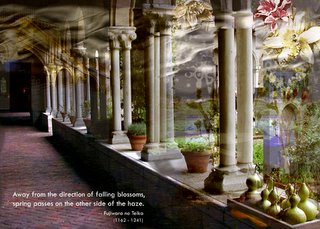Surprisingly, the artist was female: Elizabeth-Louise Vigee Le Brun. Women artists were extremely rare in the eighteenth century. Looking at the painting, you don't have to be an expert to see that this woman knew what she was doing. Her brushwork is masterful, the colors are vibrant, and the sitter's pose is relaxed.
The Legion of Honor's guide book says little about her life other than her role as court painter to Marie Antoinette. However, with a little investigative work, you can read her memoirs which were translated into English in 1903 -- in them she tells how she supported a change in the fashion of the time, and unknowingly, helped improve women's health.
Elizabeth-Louise began painting portraits as a teenager, and soon was accepting commissions. She continued to be in popular demand throughout her entire life. Her style was influenced by the famous painter, Rubens, whose masterpieces she saw and admired at the Louvre and the Luxembourg Palace.Her talent continued to grow, and in 1783 she was accepted as a member of the male-dominated French Royal Academy. During her lifetime, she painted over 660 portraits, mostly of European royalty, and over 200 landscapes.
One of her most valuable skills was being able to please and placate the delicate egos of the French aristocracy.She was appointed painter to the court of King Louis XVI, where she maintained a close friendship with Marie Antoinette, and painted her over thirty times. When the royal family was arrested during the French Revolution, she quickly left France to live and work in Rome, Naples, and Austria. She continued painting nobility, and eventually moved back to France during the reign of Emperor Napoleon I.
Elizabeth-Louise didn't care for the then fashionable powdered wigs worn by her wealthy clients. The powder bothered her. It was made from highly toxic lead white -- but its toxicity was unknown at the time. Lead was also used in the pale white makeup worn by fashionable women and was readily absorbed through the skin and scalp. Lead poisoning was most likely responsible for many of the ailments suffered by women in the past: fainting, depression, constipation, lack of appetite, and mental illness (which was accepted as eccentricity). Sadly, these effects of lead poisoning came to be thought of as "ladylike" and normal.
Elizabeth-Louise preferred her portrait sitters to wear their own hair -- no wig -- and show its natural color in a simple and unpretentious hairstyle.
One of her clients, the Countess de Grammont-Caderousse, was a trend-setter, who was always dressed in the latest styles and who was immediately copied by other women. Elizabeth-Louise convinced the Countess to pose for her portrait dressed as a simple countrywoman, with her dark brown-black hair arranged nicely. After the first sitting, the Countess went directly to the opera without changing her hair. There she attracted attention and was admired. A fashion revolution had begun.
Painted later while living in Rome, the Legion's portrait of Hyacinthe Gabrielle Roland shows the continued trend of wearing hair in its natural flowing state. Such portraits were popular, and continued to influence hairstyles. Friends of portrait sitters wanted to emulate the elegance and beauty that they saw in the finished paintings. Thankfully, women in great numbers abandoned wearing toxic powdered wigs.
Many people walk past and view the portrait of Ms. Rolande at the Legion of Honor. Very few people realize that there is a story behind the artist. Although overlooked as an artist, Elizabeth-Louise Vigee Le Brun effectively changed the fashion of the day, and unwittingly spared many women from lead poisoning.
The next time you visit the Legion, look for that portrait and take a moment to ponder how, in sometimes unexpected ways, art really can change the world.

























